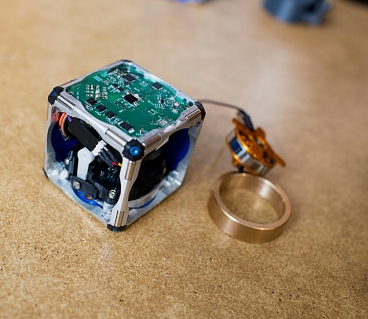
Replication, including molecular assemblers and nanofactories, while impressive in and of itself, is also the first step to self-replication, an often apocalyptic trope in science fiction. Grey goo is perhaps the most dramatic end-of-days self-replication scenario, involving robots that consume everything on Earth in their furious and unstoppable replication. Michael Crichton’s Prey and Greg Bear’s The Forge of God, in addition to Terminator II, Stargate and slew of others explore what could happen if artificial intelligence figures out how to reproduce without having to worry about the messy details of sex, pregnancy, and gestation. Or child rearing.
As of right now, it seems a few current problems have higher apocalyptic probability than grey goo, but scientists are making major strides in developing self-replicating robots. And, at least at the moment, those strides are nothing short of awesome.
Researchers at MIT have developed a new type of modular robot that can climb, move, roll, leap, and self-assemble. M-Blocks are deceptively simply little robot cubes that seem to be self-contained—they have no wheels, latches, or wings. What each M-Block does have is a flywheel that knows how to move, revolving up to 20,000 times per minute. It moves so quickly that when it brakes, the cube experiences angular momentum. And just when it seems the M-Blocks might fly out of control, the magnets on every cube face guide them into position and facilitate their assembly.
The major advancement demonstrated by the M-Block is a seemingly unlikely one—letting go of static stability, the prevailing conventional theory of existing self-assembly algorithms. Static stability means that as soon as a system stops moving, the parts will stay where they are, rather than experiencing inertia or angular momentum. It makes sense that this has been the governing principle of self-assembly algorithms, but watching the M-Blocks move, it makes sense that the MIT researchers abandoned it in favor of using the magnets to align the moving cubes.
Each cube edge has two rotating cylindrical magnets, kind of like rolling pins. Those magnets rotate to align north poles with south and south with north as the cubes draw near one another, so any cube face can attach to any other cube face. The beveled edges of the cubes create a gap when the cubes face one another, enabling the bevels and the magnets to touch when the cubes slide or flip on each other, strengthening the connection. This anchor, along with four additional pairs of smaller magnets, help the cubes snap in place against one another.
Ultimately, the researchers hope they can refine this model so at some point, the cubes can configure and reconfigure themselves into useful shapes, such as equipment or furniture. Armies of cubes could even repair structures or help in emergency situations. Eventually, researchers could miniaturize this model—you know, so they can create a hoard of tiny robots that can self-assemble into something terrifying, like the T-1000.
Other recent advances demonstrate that self-assembled robots don’t have to stay on the ground. Distributed Flight Array, a self-assembling modular robot developed by researchers at the Swiss Federal Institute of Technology, can drive and fly. The individual parts assemble on the ground at a dynamically-generated meeting point, and then via infrared light communication (or, in previous versions, magnets and pins), they latch together and take to the air. Each robot contains a rotor, so the placement of each robot affects how the assembled drone will fly. The take-off is an orchestrated feat—half the rotors turn clockwise while the other half turn counter-clockwise. The robots then adjust to counteract yaw and mid-air disturbances or to correct positioning and stability.
Right now, I have nothing but warm fuzzies for these awesome robots. But if they start to swarm, that feeling might change. Who knows—if science fiction is any indicator, we might have occasion to use that old warning system: one if by land, two if by sea.
